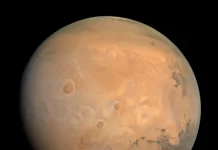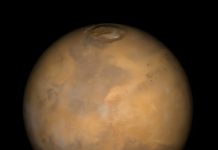
NASA’s Curiosity rover has captured breathtaking images of red and green-tinted clouds drifting across the Martian sky. These clouds, called noctilucent clouds (which means “night shining” in Latin), appear at twilight and are visible because the setting sun scatters light through them.
The images, taken on January 17, 2024, during a 16-minute observation, show delicate, glowing clouds floating high above Mars. Some of these clouds even display a rainbow-like iridescence, similar to “mother-of-pearl” clouds seen on Earth. These dazzling colors form when tiny cloud particles scatter sunlight.
What Are These Martian Clouds Made Of?
Clouds on Mars can be made of either water ice or carbon dioxide ice (commonly known as dry ice). Because Mars’ atmosphere is mostly carbon dioxide (95%), the higher-altitude clouds in these images are made of carbon dioxide ice. They form between 37 and 50 miles (60 to 80 kilometers) above the surface.
The images also show white plumes of ice falling through the air. These dry ice clouds descend as low as 31 miles (50 kilometers) before evaporating due to rising temperatures. Meanwhile, water-ice clouds can be seen moving in the opposite direction at similar altitudes.
When Were Twilight Clouds First Seen on Mars?
Scientists first spotted twilight clouds on Mars in 1997, when NASA’s Pathfinder mission captured images of them. However, Curiosity didn’t detect them until 2019, when it took its first images of iridescent Martian clouds.
This marks the fourth Mars year that Curiosity has recorded these fascinating clouds, which always appear in the same season—early fall in the southern hemisphere.
Mark Lemmon, an atmospheric scientist at the Space Science Institute in Colorado, has been studying these clouds for years. “At first, I thought the colors were a glitch in the camera,” he said. “Now, we can predict when they’ll appear and plan our shots in advance.”
Each observation helps scientists learn more about cloud formation, particle size, and how clouds grow in Mars’ thin atmosphere.
A Mystery: Why Are These Clouds Only Seen in Some Places?
One big mystery is why carbon dioxide ice clouds are only spotted in certain areas of Mars. Curiosity is exploring Gale Crater, near the Martian equator. Meanwhile, NASA’s Perseverance rover, which landed in Jezero Crater in 2021, hasn’t seen any of these special clouds.
Lemmon and his team think that gravity waves—atmospheric waves that affect temperature—might be responsible. These waves could be cooling certain parts of the atmosphere enough for carbon dioxide to freeze into ice. However, scientists still don’t fully understand how these waves work on Mars.
Curiosity’s Camera Challenges
The twilight clouds in the latest images are framed in a partial circle due to a technical issue with Curiosity’s Mastcam. One of the camera’s filter wheels is stuck between positions. Despite this, the rover team at NASA’s Jet Propulsion Laboratory (JPL) can still use both Mastcam cameras for stunning color images.
What’s Next for Curiosity?
Curiosity recently finished studying an area called Gediz Vallis channel and is heading toward a new site with boxwork formations—rock fractures shaped like spiderwebs, possibly formed by ancient groundwater.
The rover also captured images of a small impact crater called “Rustic Canyon”, which is about 67 feet (20 meters) wide. This crater is very old, and erosion has worn away much of its rim. Scientists study craters like this because impacts can bring buried materials to the surface, revealing clues about Mars’ history.
One of Curiosity’s main goals is to search for organic molecules—the building blocks of life. Since Mars’ surface is exposed to harsh radiation, ancient buried rocks might provide better clues about whether Mars ever supported microbial life billions of years ago.
With each new discovery, Curiosity continues to uncover the mysteries of Mars, from its glowing twilight clouds to its ancient landscape.
The research findings can be found in Geophysical Research Letters.
Copyright © 2025 Knowridge Science Report. All rights reserved.



